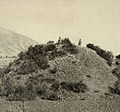History of Kashmir
| Advanced search |
- About 7 results found and you can help!
According to folk etymology, the name "Kashmir" means "desiccated land" (from the Sanskrit: Ka = water and shimeera = desiccate). In the Rajatarangini, a history of Kashmir written by Kalhana in the mid-12th century, it is stated that the valley of Kashmir was formerly a lake. According to Hindu mythology, the lake was drained by the great rishi or sage, Kashyapa, son of Marichi, son of Brahma, by cutting the gap in the hills at Baramulla (Varaha-mula). When Kashmir had been drained, Kashyapa asked Brahmans to settle there. This is still the local tradition, and in the existing physical condition of the country, we may see some ground for the story which has taken this form. The name of Kashyapa is by history and tradition connected with the draining of the lake, and the chief town or collection of dwellings in the valley was called Kashyapa-pura, which has been identified with Kaspapyros of Hecataeus (apud Stephanus of Byzantium) and Kaspatyros of Herodotus (3.102, 4.44). Kashmir is also believed to be the country meant by Ptolemy's Kaspeiria.
- See also: Wikipedia
- Related: Kashmiriyat, Dynasties of Ancient Kashmir, Sharada Peeth, Buddhism in Kashmir, Harsha of Kashmir, History of Ladakh, Rajatarangini, History of Azad Kashmir, History of Gilgit–Baltistan
| Baharistan -i Shahi A Chronicle of Medevial Kashmi... Baharistan -i Shahi A Chronicle of Medevial Kashmir translated into English ikashmir.net/baharistan/doc/baharistan.pdf - Web |
| Proclamation of 1 May 1951 on Jammu & Kashmir Cons... Proclamation of 1 May 1951 on Jammu & Kashmir Constituent Assembly jammukashmir.nic.in/govt/cntit1.htm#1 - Web |
| History of The Kashmiri Pandits Race History of The Kashmiri Pandits Race shehjar.kashmirgroup.com/.../070824025005_Pandit%20History - Web |
Gallery for «History of Kashmir»
- Kashmiri-home-life-1890.jpg
- Kashmir-Accession-Document-a.jpg
Average relevance
| Conflict in Kashmir: Selected Internet Resources b... Conflict in Kashmir: Selected Internet Resources by the Library, University of California, Berkeley, USA; Bibliographies and Web-Bibliographies list www.lib.berkeley.edu/SSEAL/SouthAsia/kashmir.html - Web |
| History of Kashmir. History of Kashmir. imkashmiri.com/articles-on-kashmir/33-kashmir-history.html - Web |
| Kashmir Website with Historical Timeline Kashmir Website with Historical Timeline www.kashmirlibrary.org - Web |
| Coins of the Kashmir Sultanate (1346-1586) Coins of the Kashmir Sultanate (1346-1586) coinindia.com/galleries-kashmirsultans.html - Web |



